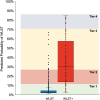Recovery Potential in Patients Who Died After Withdrawal of Life-Sustaining Treatment: A TRACK-TBI Propensity Score Analysis
- PMID: 38739032
- PMCID: PMC11564834
- DOI: 10.1089/neu.2024.0014
Recovery Potential in Patients Who Died After Withdrawal of Life-Sustaining Treatment: A TRACK-TBI Propensity Score Analysis
Abstract
Among patients with severe traumatic brain injury (TBI), there is high prognostic uncertainty but growing evidence that recovery of independence is possible. Nevertheless, families are often asked to make decisions about withdrawal of life-sustaining treatment (WLST) within days of injury. The range of potential outcomes for patients who died after WLST (WLST+) is unknown, posing a challenge for prognostic modeling and clinical counseling. We investigated the potential for survival and recovery of independence after acute TBI in patients who died after WLST. We used Transforming Research and Clinical Knowledge in TBI (TRACK-TBI) data and propensity score matching to pair participants with WLST+ to those with a similar probability of WLST (based on demographic and clinical characteristics), but for whom life-sustaining treatment was not withdrawn (WLST-). To optimize matching, we divided the WLST- cohort into tiers (Tier 1 = 0-11%, Tier 2 = 11-27%, Tier 3 = 27-70% WLST propensity). We estimated the level of recovery that could be expected in WLST+ participants by evaluating 3-, 6-, and 12-month Glasgow Outcome Scale-Extended (GOSE) and Disability Rating Scale outcomes in matched WLST- participants. Of 90 WLST+ participants (80% male, mean [standard deviation; SD] age = 59.2 [17.9] years, median [IQR] days to WLST = 5.4 [2.2, 11.7]), 80 could be matched to WLST- participants. Of 56 WLST- participants who were followed at 6 months, 31 (55%) died. Among survivors in the overall sample and survivors in Tiers 1 and 2, more than 30% recovered at least partial independence (GOSE ≥4). In Tier 3, recovery to GOSE ≥4 occurred at 12 months, but not 6 months, post-injury. These results suggest a substantial proportion of patients with TBI and WLST may have survived and achieved at least partial independence. However, death or severe disability is a common outcome when the probability of WLST is high. While further validation is needed, our findings support a more cautious clinical approach to WLST and more complete reporting on WLST in TBI studies.
Keywords: coma; traumatic brain injury; withdrawal of life-sustaining treatment.
Figures



References
Publication types
MeSH terms
Grants and funding
LinkOut - more resources
Full Text Sources

